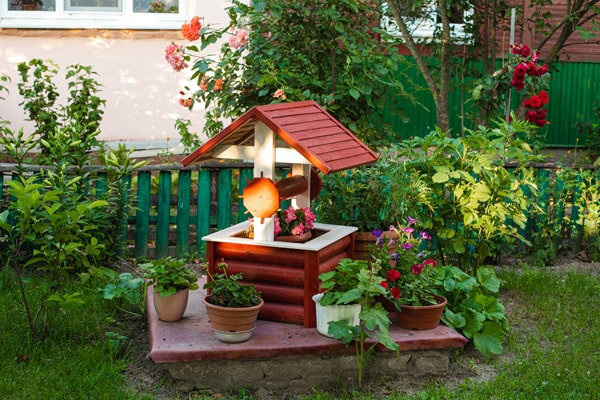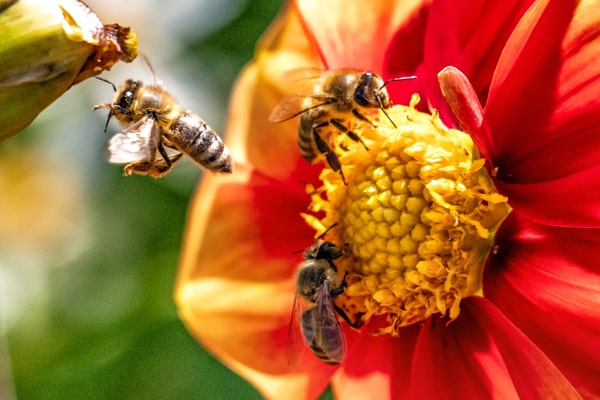In gardening, sustainability refers to practices that aim to perpetuate the existence of plants and ecosystems while minimizing environmental harm. Sustainable gardening involves adopting techniques that reduce resource consumption, preserve biodiversity, and promote long-term ecological balance.
Flowering plants are notorious for requiring more water and fertilizers to produce flowers. That said, it’s possible to grow a colorful garden while implementing conscientious practices such as saving water and energy.
Is sustainable gardening possible when growing flowering plants? You bet! Here are some tips to help you create an eco-friendly flower garden:
Contents []
What is Sustainable Gardening?
While there is no universally defined technical description of sustainable gardening, the concept revolves around creating a greener future and leaving the environment unharmed during the cultivation of plant life.
Sustainable gardening aims to reduce the use of water, energy, and synthetic chemicals. This can be achieved by employing practices like composting to minimize the use of synthetic fertilizers and limit greenhouse gas emissions.
Practices like minimal irrigation, rainwater harvesting, and designing rain gardens help conserve water, prevent runoff, and promote healthy soil moisture levels.
Sustainable gardening promotes the inclusion of native plants, as they require fewer resources, provide natural habitats and food sources for local wildlife, and support biodiversity.
Conscientious practices are done to consider the long-term impact of gardening practices on future generations. By making conscious choices and taking steps to minimize harm, sustainable gardening aims to create a positive environmental legacy.
By embracing sustainable gardening principles, individuals can contribute to preserving the environment, conserving resources, promoting biodiversity, and creating beautiful and resilient garden spaces.
5 Strategies for Sustainable Flower Gardening
Sustainable flower gardening involves implementing practices that prioritize environmental stewardship and minimize negative impacts on the planet. Here are five clever techniques for building a sustainable flower garden:
Choose Local Flowers

Imported flowers often have a significantly higher carbon footprint than locally grown flowers. Opting for locally sourced blooms can save up to 7.9kg of carbon per bunch compared to some imported varieties. Supporting local growers reduces transportation emissions and promotes the local economy.
Use Protective Net
Consider using fine nets instead of relying on chemical sprays to protect crops from pests. Covering vulnerable plants with nets can prevent butterflies from laying eggs and protect crops from caterpillars and other leaf-munching wildlife. Investing in sturdy nets allows for their reuse year after year, reducing the need for chemical interventions.
Prioritize Soil Health

Soil is a vital component of a sustainable garden. Improving soil quality helps trap and store carbon, supports the billions of microorganisms essential for soil health, and enhances overall ecological balance. Practices such as adding compost, using organic fertilizers, and avoiding excessive tilling contribute to maintaining healthy soil.
Embrace Successional Blooms
Plan your garden to have a continuous succession of blooming flowers throughout the year. By selecting plants that flower at different times, you can provide a consistent food source for pollinators throughout the seasons. This approach helps maintain a healthy ecosystem and supports the pollinators vital to plant reproduction.
Implement Companion Planting
Companion planting involves strategically placing compatible plants together to benefit each other. For example, planting tagetes (marigold) around tomatoes can deter whiteflies, and growing garlic and onions alongside carrots can mask the carrot scent and deter carrot root flies. Companion planting reduces the need for chemical pesticides and promotes a balanced ecosystem in the garden.
You can create a more sustainable and environmentally friendly garden by incorporating these five techniques into your flower gardening practices. These methods not only benefit the planet but also promote biodiversity, support pollinators, and contribute to your garden's overall health and beauty.
How can Gardening be Sustainable?
Gardening can be made sustainable by adopting practices that minimize resource consumption and reduce environmental harm. Here are some key principles and techniques for achieving sustainable gardening:

Water Conservation: To conserve water, consider using methods such as collecting rainwater in a water butt or using a watering can instead of a hosepipe. By reducing water usage, you can help preserve this valuable resource.
Successional Blooms: Planting various flowers that bloom at different times throughout the year ensures a continuous food source for pollinators. This approach attracts essential pollinating insects to your garden, contributing to biodiversity and ecosystem health.
Companion Planting: Companion planting involves strategically placing plants together to benefit each other. For instance, planting certain flowers or herbs near vegetables can deter pests or attract beneficial insects, reducing the need for chemical pesticides.
Weather-Based Planting: Rather than following a fixed planting schedule, adapt your planting and sowing times based on the weather patterns and local climate conditions. Monitoring the last frost date and adjusting planting accordingly helps optimize plant growth and reduce the risk of crop loss.
Resilient Plant Selection: Choose plant varieties well-suited to your local climate and growing conditions. Resilient plants require less intervention, maintenance, and resources to thrive, promoting ecological balance in your garden.
Improve Soil Health: Focus on improving soil quality, as healthy soil plays a crucial role in sustainable gardening. Enhance soil fertility by adding organic matter like compost, which improves moisture retention, nutrient availability, and carbon storage. Healthy soil supports plant growth and nurtures a diverse ecosystem.
Reduce Lawn Maintenance: Reduce Lawn Maintenance: Allow lawns to grow slightly longer to conserve water and reduce the need for frequent mowing. Longer grass helps retain moisture and supports biodiversity, especially in areas prone to water shortages or droughts.
Permaculture Gardening: Adopt permaculture principles, such as using food waste for compost, allowing dead plants to become mulch, and avoiding synthetic chemicals. Permaculture emphasizes self-sufficiency, ecological harmony, and minimizing waste in the garden.
How can Flowers be Sustainable for Gardening?
To make flowers more sustainable for gardening, you can consider the following practices: Choosing local flowers is best for sustainable gardening because these plants are well-adapted to the local climate and soil conditions. These plants require less water, fertilizers, and pesticides because they are native to your region.

We highly suggest choosing flowering plants that attract pollinators, such as bees, butterflies, and birds. These garden-friendly critters play a vital role in plant reproduction and support the overall ecosystem.
It's equally important to grow plants in the right season. Seasonal planting reduces the need for artificial climate control. Plants will thrive if the conditions are right. By planting flowers in the right season, the plants will require less water, and you don't have to implement measures to improve the growing conditions.
Using natural soil conditioners like humic acid and seaweed extract instead of chemical fertilizers also helps improve soil health and develop a more resilient space for your flowering plants.
Finally, grow drought-tolerant flowering plants such as lavender, yarrow, salvia, coneflower, zinnia, marigold, California poppy, and verbena. These plants require less water and are easier to grow. Low-maintenance flowering plants also need less work to thrive.
Following these sustainable gardening practices can reduce your environmental impact, conserve resources, and create a healthy and thriving garden ecosystem.



